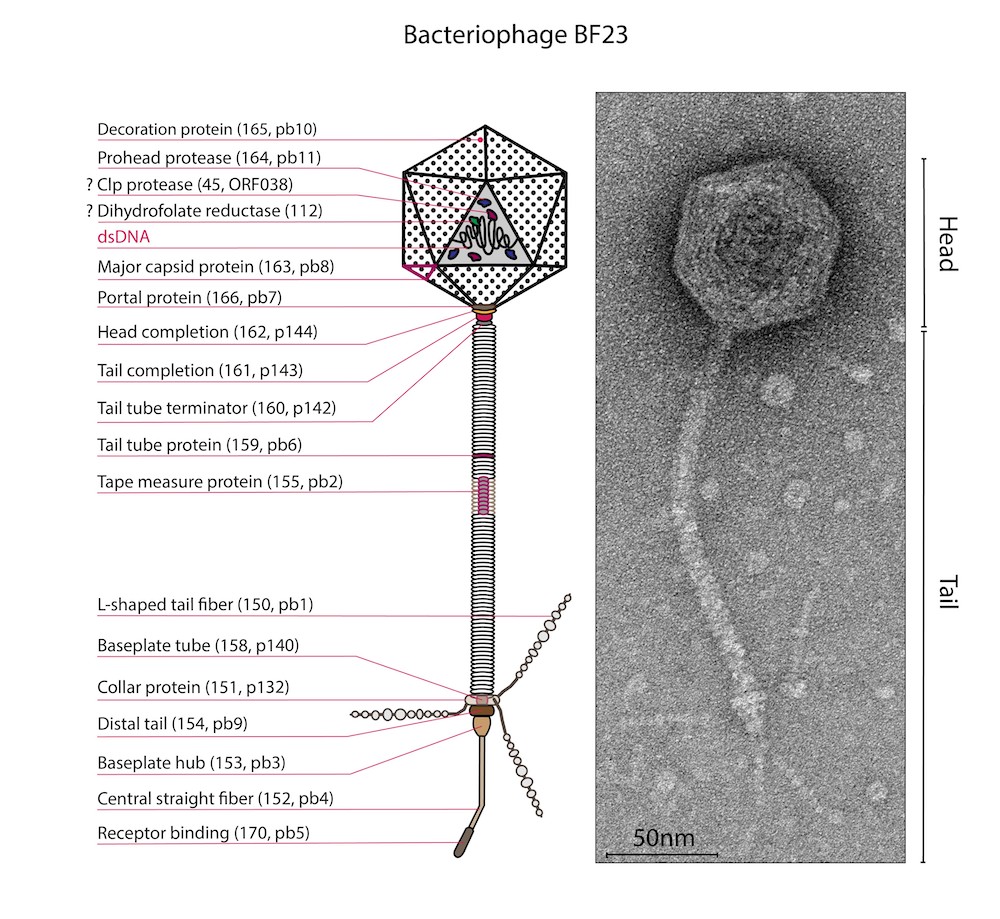Bacteriophages are natural “predators” and enemies of bacteria. They are able to recognize specific types of bacteria and are considered safe for humans. Due to the increasing resistance of pathogenic microorganisms to antibiotics, bacteriophages have recently been considered as a possible alternative to antibiotics. In a new study, a group of scientists from Skoltech Laboratory of Metagenome Analysis led by Artem Isaev, drew attention to the BF23 bacteriophage. Although it was found in 1949, the genomic sequence of the phage remained unknown. The researchers conducted genomic and proteomic analysis of the phage, and investigated how the phage interacts with bacterial immunity systems. The study is published in the microLife journal.
“T5-like bacteriophages are very protected viruses. For some reason, they masterfully deceive different bacterial immune systems: restriction modification and CRISPR-Cas, which are based on cutting any foreign DNA. For many years, scientists have been trying to figure out how they do this — they are looking for proteins that could represent novel inhibitors of RM systems, but so far they haven’t succeeded. Therefore, the BF23 phage was interesting to us for two reasons: we wanted to compare its genomic sequence with other T5-like viruses and try to use it as a model to explain how T5 bypasses protective systems,” says the leading author of the study Mikhail Skutel, a PhD student at Skoltech.
The scientists sequenced the genome and compared it with the genomes of other T5-like phages. Although the changes in the BF23’s genome are insignificant, the comparative analysis should guide the search for an “anti-restriction component,” since such protein should be conserved among all T5-like phages. Unlike other bacteriophages, which immediately inject all their genomic material into a bacterial cell, T5-like phages carry out infection in two stages and first inject only a small part of their genome, which is required to prepare the cell for successful infection.
“At the first stage of infection, special early phage genes begin to work actively and many interesting things happen: not only the genome of the bacterial cell is completely destroyed, but also the nucleotides themselves — the building blocks that make up the genomic DNA of bacteria. Apparently, it is at this stage that the phage is producing a component that will subsequently protect the rest of the phage genome from bacterial immune enzymes,” adds Mikhail Skutel.
In the article, the authors tested the action of several T5-like bacteriophages against a variety of restriction modification protection systems. These systems recognize and cut special DNA sequences if they do not have a protective label — methyl group. It turned out that the cell is protected from infection only when the recognition sites are located in the very early part of the genome that penetrates the cell at the first stage of infection. For yet undetermined reasons, sites located in the rest of the genome remain invisible to bacterial nucleases. Presumably, at the second stage of infection, the nucleases have already been inactivated by the phage, or the phage was able to protect its own DNA.
The group of researchers also managed to show that T5-like bacteriophages avoid methylation of their own genome. “Methylation is a chemical reaction, which results in a special label, a methyl radical, attached to DNA. Among other functions, methylation is required to regulate expression of genes. When bacteriophage infects the cell and successfully completes its life cycle, it can be assumed that its genome will acquire methylation characteristic of bacterial DNA. But that’s not the case with BF23 and T5 bacteriophages: we have shown that their DNA is devoid of a methyl label. What is the mechanism and purpose of this phenomenon remains to be determined. Perhaps, avoiding methylation helps the bacteriophage distinguish its DNA from the methylated DNA of the bacterium, which should be destroyed during the infection,” explains Mikhail Skutel.

Model of BF23 virion with depicted positions of proteins identified by mass spectrometry analysis of phage virion. Credit: Mikhail Skutel and coauthors
Contact information:
Skoltech Communications
+7 (495) 280 14 81
